SIMPONI
-
golimumab injection, solution
Centocor Ortho Biotech Inc.
----------
|
||||||||||||||||||||||||||
FULL PRESCRIBING INFORMATION
WARNINGS
SERIOUS INFECTIONS
Patients treated with SIMPONI™ are at increased risk for developing serious infections that may lead to hospitalization or death [see Warnings and Precautions (5.1)]. Most patients who developed these infections were taking concomitant immunosuppressants such as methotrexate or corticosteroids.
SIMPONI should be discontinued if a patient develops a serious infection.
Reported infections include:
- Active tuberculosis, including reactivation of latent tuberculosis. Patients with tuberculosis have frequently presented with disseminated or extrapulmonary disease. Patients should be tested for latent tuberculosis before SIMPONI use and during therapy. Treatment for latent infection should be initiated prior to SIMPONI use.
- Invasive fungal infections, including histoplasmosis, coccidioidomycosis, and pneumocystosis. Patients with histoplasmosis or other invasive fungal infections may present with disseminated, rather than localized, disease. Antigen and antibody testing for histoplasmosis may be negative in some patients with active infection. Empiric anti-fungal therapy should be considered in patients at risk for invasive fungal infections who develop severe systemic illness.
- Bacterial, viral, and other infections due to opportunistic pathogens.
The risks and benefits of treatment with SIMPONI should be carefully considered prior to initiating therapy in patients with chronic or recurrent infection.
Patients should be closely monitored for the development of signs and symptoms of infection during and after treatment with SIMPONI, including the possible development of tuberculosis in patients who tested negative for latent tuberculosis infection prior to initiating therapy [see Warning and Precautions (5.1)].
MALIGNANCY
Lymphoma and other malignancies, some fatal, have been reported in children and adolescent patients treated with TNF blockers, of which SIMPONI is a member [see Warning and Precautions (5.2)].
1.0 INDICATIONS AND USAGE
1.1 Rheumatoid Arthritis
SIMPONI, in combination with methotrexate, is indicated for the treatment of adult patients with moderately to severely active rheumatoid arthritis.
1.2 Psoriatic Arthritis
SIMPONI, alone or in combination with methotrexate, is indicated for the treatment of adult patients with active psoriatic arthritis.
1.3 Ankylosing Spondylitis
SIMPONI is indicated for the treatment of adult patients with active ankylosing spondylitis.
2.0 DOSAGE AND ADMINISTRATION
2.1 Rheumatoid Arthritis, Psoriatic Arthritis, Ankylosing Spondylitis
The SIMPONI dose regimen is 50 mg administered by subcutaneous (SC) injection once a month.
For patients with rheumatoid arthritis (RA), SIMPONI should be given in combination with methotrexate and for patients with psoriatic arthritis (PsA) or ankylosing spondylitis (AS), SIMPONI may be given with or without methotrexate or other non-biologic DMARDs. For patients with RA, PsA, or AS, corticosteroids, non-biologic DMARDs, and/or NSAIDs may be continued during treatment with SIMPONI.
2.2 Monitoring to Assess Safety
Prior to initiating SIMPONI and periodically during therapy, patients should be evaluated for active tuberculosis and tested for latent infection [see Warnings and Precautions (5.1)].
2.3 General Considerations for Administration
SIMPONI is intended for use under the guidance and supervision of a physician. After proper training in subcutaneous injection technique, a patient may self inject with SIMPONI if a physician determines that it is appropriate. Patients should be instructed to follow the directions provided in the Medication Guide [see Medication Guide (17.3)]. To ensure proper use, allow the prefilled syringe or autoinjector to sit at room temperature outside the carton for 30 minutes prior to subcutaneous injection. Do not warm SIMPONI in any other way.
Prior to administration, visually inspect the solution for particles and discoloration through the viewing window. SIMPONI should be clear to slightly opalescent and colorless to light yellow. The solution should not be used if discolored, or cloudy, or if foreign particles are present. Any leftover product remaining in the prefilled syringe or prefilled autoinjector should not be used. NOTE: The needle cover on the prefilled syringe as well as the prefilled syringe in the autoinjector contains dry natural rubber (a derivative of latex), which should not be handled by persons sensitive to latex.
Injection sites should be rotated and injections should never be given into areas where the skin is tender, bruised, red, or hard.
3.0 DOSAGE FORMS AND STRENGTHS
SmartJect™ Autoinjector
Each single dose SmartJect autoinjector contains a prefilled glass syringe (27 gauge ½ inch) providing 50 mg of SIMPONI per 0.5 mL of solution.
Prefilled Syringe
Each single dose prefilled glass syringe (27 gauge ½ inch) contains 50 mg of SIMPONI per 0.5 mL of solution.
4.0 CONTRAINDICATIONS
None.
5.0 WARNINGS AND PRECAUTIONS
(see Boxed WARNINGS)
5.1 Serious Infections
Serious and sometimes fatal infections due to bacterial, mycobacterial, invasive fungal, viral, protozoal, or other opportunistic pathogens have been reported in patients receiving TNF-blockers including SIMPONI. Among opportunistic infections, tuberculosis, histoplasmosis, aspergillosis, candidiasis, coccidioidomycosis, listeriosis, and pneumocystosis were the most commonly reported with TNF-blockers. Patients have frequently presented with disseminated rather than localized disease, and were often taking concomitant immunosuppressants such as methotrexate or corticosteroids. The concomitant use of a TNF-blocker and abatacept or anakinra was associated with a higher risk of serious infections; therefore, the concomitant use of SIMPONI and these biologic products is not recommended [see Warning and Precautions (5.5, 5.6) and Drug Interactions (7.2)].
Treatment with SIMPONI should not be initiated in patients with an active infection, including clinically important localized infections. The risks and benefits of treatment should be considered prior to initiating SIMPONI in patients:
- with chronic or recurrent infection;
- who have been exposed to tuberculosis;
- with a history of an opportunistic infection;
- who have resided or traveled in areas of endemic tuberculosis or endemic mycoses, such as histoplasmosis, coccidioidomycosis, or blastomycosis; or
- with underlying conditions that may predispose them to infection.
Patients should be closely monitored for the development of signs and symptoms of infection during and after treatment with SIMPONI. SIMPONI should be discontinued if a patient develops a serious infection, an opportunistic infection, or sepsis. A patient who develops a new infection during treatment with SIMPONI should undergo a prompt and complete diagnostic workup appropriate for an immunocompromised patient, appropriate antimicrobial therapy should be initiated, and the patient should be closely monitored.
In controlled Phase 3 trials through Week 16 in patients with RA, PsA, and AS, serious infections were observed in 1.4% of SIMPONI-treated patients and 1.3% of control-treated patients. In the controlled Phase 3 trials through Week 16 in patients with RA, PsA, and AS, the incidence of serious infections per 100 patient-years of follow-up was 5.4 (95% CI: 4.0, 7.2) for the SIMPONI group and 5.3 (95% CI: 3.1, 8.7) for the placebo group. Serious infections observed in SIMPONI-treated patients included sepsis, pneumonia, cellulitis, abscess, tuberculosis, invasive fungal infections, and hepatitis B infection.
Tuberculosis
Cases of reactivation of tuberculosis or new tuberculosis infections have been observed in patients receiving TNF-blockers, including patients who have previously received treatment for latent or active tuberculosis. Patients should be evaluated for tuberculosis risk factors and tested for latent infection prior to initiating SIMPONI and periodically during therapy.
Treatment of latent tuberculosis infection prior to therapy with TNF-blockers has been shown to reduce the risk of tuberculosis reactivation during therapy. Induration of 5 mm or greater with tuberculin skin testing should be considered a positive test result when assessing if treatment for latent tuberculosis is needed prior to initiating SIMPONI, even for patients previously vaccinated with Bacille Calmette-Guerin (BCG).
Anti-tuberculosis therapy should also be considered prior to initiation of SIMPONI in patients with a past history of latent or active tuberculosis in whom an adequate course of treatment cannot be confirmed, and for patients with a negative test for latent tuberculosis but having risk factors for tuberculosis infection. Consultation with a physician with expertise in the treatment of tuberculosis is recommended to aid in the decision whether initiating anti-tuberculosis therapy is appropriate for an individual patient.
Patients should be closely monitored for the development of signs and symptoms of tuberculosis including patients who tested negative for latent tuberculosis infection prior to initiating therapy.
Tuberculosis should be strongly considered in patients who develop a new infection during SIMPONI treatment, especially in patients who have previously or recently traveled to countries with a high prevalence of tuberculosis, or who have had close contact with a person with active tuberculosis.
In the controlled and uncontrolled portions of the Phase 2 RA and Phase 3 RA, PsA, and AS trials, the incidence of active TB was 0.23 and 0 per 100 patient-years in 2347 SIMPONI-treated patients and 674 placebo-treated patients, respectively. Cases of TB included pulmonary and extra pulmonary TB. The overwhelming majority of the TB cases occurred in countries with a high incidence rate of TB.
Invasive Fungal Infections
For SIMPONI-treated patients who reside or travel in regions where mycoses are endemic, invasive fungal infection should be suspected if they develop a serious systemic illness. Appropriate empiric antifungal therapy should be considered while a diagnostic workup is being performed. Antigen and antibody testing for histoplasmosis may be negative in some patients with active infection. When feasible, the decision to administer empiric antifungal therapy in these patients should be made in consultation with a physician with expertise in the diagnosis and treatment of invasive fungal infections and should take into account both the risk for severe fungal infection and the risks of antifungal therapy.
Hepatitis B Virus Reactivation
The use of TNF-blockers including SIMPONI has been associated with reactivation of hepatitis B virus (HBV) in patients who are chronic hepatitis B carriers (i.e., surface antigen positive). In some instances, HBV reactivation occurring in conjunction with TNF-blocker therapy has been fatal. The majority of these reports have occurred in patients who received concomitant immunosuppressants.
Patients at risk for HBV infection should be evaluated for prior evidence of HBV infection before initiating TNF-blocker therapy. The risks and benefits of treatment should be considered prior to prescribing TNF-blockers, including SIMPONI, to patients who are carriers of HBV. Adequate data are not available on whether anti-viral therapy can reduce the risk of HBV reactivation in HBV carriers who are treated with TNF-blockers. Patients who are carriers of HBV and require treatment with TNF-blockers should be closely monitored for clinical and laboratory signs of active HBV infection throughout therapy and for several months following termination of therapy.
In patients who develop HBV reactivation, TNF-blockers should be stopped and antiviral therapy with appropriate supportive treatment should be initiated. The safety of resuming TNF-blockers after HBV reactivation has been controlled is not known. Therefore, prescribers should exercise caution when considering resumption of TNF-blockers in this situation and monitor patients closely.
5.2 Malignancies
Malignancies, some fatal, have been reported among children, adolescents, and young adults who received treatment with TNF-blocking agents (initiation of therapy ≤ 18 years of age), of which SIMPONI is a member. Approximately half the cases were lymphomas, including Hodgkin's and non-Hodgkin's lymphoma. The other cases represented a variety of malignancies, including rare malignancies that are usually associated with immunosuppression, and malignancies that are not usually observed in children and adolescents. The malignancies occurred after a median of 30 months (range 1 to 84 months) after the first dose of TNF blocker therapy. Most of the patients were receiving concomitant immunosuppressants. These cases were reported post-marketing and are derived from a variety of sources, including registries and spontaneous postmarketing reports.
The risks and benefits of TNF-blocker treatment including SIMPONI should be considered prior to initiating therapy in patients with a known malignancy other than a successfully treated non-melanoma skin cancer (NMSC) or when considering continuing a TNF-blocker in patients who develop a malignancy.
In the controlled portions of clinical trials of TNF-blockers including SIMPONI, more cases of lymphoma have been observed among patients receiving anti-TNF treatment compared with patients in the control groups. During the controlled portions of the Phase 2 trials in RA, and the Phase 3 trials in RA, PsA and AS, the incidence of lymphoma per 100 patient-years of follow-up was 0.21 (95% CI: 0.03, 0.77) in the combined SIMPONI group compared with an incidence of 0 (95% CI: 0., 0.96) in the placebo group. In the controlled and uncontrolled portions of these clinical trials in 2347 SIMPONI-treated patients with a median follow-up of 1.4 years, the incidence of lymphoma was 3.8-fold higher than expected in the general U.S. population according to the SEER database (adjusted for age, gender, and race).1 Patients with RA and other chronic inflammatory diseases, particularly patients with highly active disease and/or chronic exposure to immunosuppressant therapies, may be at higher risk (up to several fold) than the general population for the development of lymphoma, even in the absence of TNF-blocking therapy. Cases of acute and chronic leukemia have been reported with postmarketing TNF-blocker use in rheumatoid arthritis and other indications. Even in the absence of TNF blocker therapy, patients with rheumatoid arthritis may be at a higher risk (approximately 2-fold) than the general population for the development of leukemia.
During the controlled portions of the Phase 2 trial in RA, and the Phase 3 trials in RA, PsA and AS, the incidence of malignancies other than lymphoma per 100 patient-years of follow-up was not elevated in the combined SIMPONI group compared with the placebo group. In the controlled and uncontrolled portions of these trials, the incidence of malignancies, other than lymphoma, in SIMPONI-treated patients was similar to that expected in the general U.S. population according to the SEER database (adjusted for age, gender, and race).1
In controlled trials of other TNF-blockers in patients at higher risk for malignancies (e.g., patients with COPD, patients with Wegener's granulomatosis treated with concomitant cyclophosphamide) a greater portion of malignancies occurred in the TNF-blocker group compared to the controlled group. In an exploratory 1-year clinical trial evaluating the use of 50, 100 and 200 mg of SIMPONI in 309 patients with severe persistent asthma, 6 patients developed malignancies other than NMSC in the SIMPONI groups compared to none in the control group. Three of the 6 patients were in the 200 mg SIMPONI group.
5.3 Congestive Heart Failure
Cases of worsening congestive heart failure (CHF) and new onset CHF have been reported with TNF-blockers. In several exploratory trials of other TNF-blockers in the treatment of CHF, there were greater proportions of TNF-blocker treated patients who had CHF exacerbations requiring hospitalization or increased mortality. SIMPONI has not been studied in patients with a history of CHF and SIMPONI should be used with caution in patients with CHF. If a decision is made to administer SIMPONI to patients with CHF, these patients should be closely monitored during therapy, and SIMPONI should be discontinued if new or worsening symptoms of CHF appear.
5.4 Demyelinating Disorders
Use of TNF-blockers has been associated with cases of new onset or exacerbation of central nervous system (CNS) demyelinating disorders, including multiple sclerosis (MS). While no trials have been performed evaluating SIMPONI in the treatment of patients with MS, another TNF-blocker was associated with increased disease activity in patients with MS. Therefore, prescribers should exercise caution in considering the use of TNF-blockers including SIMPONI in patients with CNS demyelinating disorders including MS.
5.5 Use with Abatacept
In controlled trials, the concurrent administration of another TNF-blocker and abatacept was associated with a greater proportion of serious infections than the use of a TNF-blocker alone; and the combination therapy, compared to the use of a TNF-blocker alone, has not demonstrated improved clinical benefit in the treatment of RA. Therefore, the combination of TNF-blockers including SIMPONI and abatacept is not recommended [see Drug Interactions (7.2)].
5.6 Use with Anakinra
Concurrent administration of anakinra (an interleukin-1 antagonist) and another TNF-blocker, was associated with a greater portion of serious infections and neutropenia and no additional benefits compared with the TNF-blocker alone. Therefore, the combination of anakinra with TNF-blockers, including SIMPONI, is not recommended [see Drug Interactions 7.2].
5.7 Hematologic Cytopenias
There have been post-marketing reports of pancytopenia, leukopenia, neutropenia, aplastic anemia, and thrombocytopenia in patients receiving TNF-blockers. Although, there were no cases of severe cytopenias seen in the SIMPONI clinical trials, caution should be exercised when using TNF-blockers, including SIMPONI, in patients who have significant cytopenias.
5.8 Vaccinations
Patients treated with SIMPONI may receive vaccinations, except for live vaccines. No data are available on the response to live vaccination or the risk of infection, or transmission of infection after the administration of live vaccines to patients receiving SIMPONI. In the Phase 3 PsA study, after pneumococcal vaccination, a similar proportion of SIMPONI-treated and placebo-treated patients were able to mount an adequate immune response of at least a 2-fold increase in antibody titers to pneumococcal polysaccharide vaccine. In both SIMPONI-treated and placebo-treated patients, the proportions of patients with response to pneumococcal vaccine were lower among patients receiving MTX compared with patients not receiving MTX. The data suggest that SIMPONI does not suppress the humoral immune response to the pneumococcal vaccine.
6.0 ADVERSE REACTIONS
Because clinical trials are conducted under widely varying conditions, adverse reaction rates observed in the clinical trials of a drug cannot be directly compared to rates in the clinical trials of another drug and may not reflect the rates observed in clinical practice.
6.1 Clinical Studies Experience
The safety data described below are based on 5 pooled, randomized, double-blind, controlled Phase 3 trials in patients with RA, PsA, and AS (Studies RA-1, RA-2, RA-3, PsA, and AS) [see Clinical Studies (14.1, 14.2 and 14.3)]. These 5 trials included 639 control-treated patients and 1659 SIMPONI-treated patients including 1089 with RA, 292 with PsA, and 278 with AS. The proportion of patients who discontinued treatment due to adverse reactions in the controlled Phase 3 trials through Week 16 in RA, PsA and AS was 2% for SIMPONI-treated patients and 3% for placebo-treated patients. The most common adverse reactions leading to discontinuation of SIMPONI in the controlled Phase 3 trials through Week 16 were sepsis (0.2%), alanine aminotransferase increased (0.2%), and aspartate aminotransferase increased (0.2%).
The most serious adverse reactions were:
- Serious Infections [see Warnings and Precautions (5.1)]
- Malignancies [see Warnings and Precautions (5.2)]
Upper respiratory tract infection and nasopharyngitis were the most common adverse reactions reported in the combined Phase 3 RA, PsA and AS trials through Week 16, occurring in 7% and 6% of SIMPONI-treated patients as compared with 6% and 5% of control-treated patients, respectively.
Infections
In controlled Phase 3 trials through Week 16 in RA, PsA, and AS, infections were observed in 28% of SIMPONI-treated patients compared to 25% of control-treated patients [for Serious Infections, see Warnings and Precautions (5.1)].
Liver Enzyme Elevations
There have been reports of severe hepatic reactions including acute liver failure in patients receiving TNF-blockers. In controlled Phase 3 trials of SIMPONI in patients with RA, PsA, and AS through Week 16, ALT elevations ≥ 5 × ULN occurred in 0.2% of control-treated patients and 0.7% of SIMPONI-treated patients and ALT elevations ≥ 3 × ULN occurred in 2% of control-treated patients and 2% of SIMPONI-treated patients. Since many of the patients in the Phase 3 trials were also taking medications that cause liver enzyme elevations (e.g., NSAIDS, MTX), the relationship between golimumab and liver elevation is not clear.
Autoimmune Disorders and Autoantibodies
The use of TNF-blockers has been associated with the formation of autoantibodies and, rarely, with the development of a lupus-like syndrome. In the controlled Phase 3 trials in patients with RA, PsA, and AS through Week 14, there was no association of SIMPONI treatment and the development of newly positive anti-dsDNA antibodies.
Injection Site Reactions
In controlled Phase 3 trials through Week 16 in RA, PsA and AS, 6% of SIMPONI-treated patients had injection site reactions compared with 2% of control-treated patients. The majority of the injection site reactions were mild and the most frequent manifestation was injection site erythema. In controlled Phase 2 and 3 trials in RA, PsA, and AS, no patients treated with SIMPONI developed anaphylactic reactions.
Psoriasis: New-Onset and Exacerbations
Cases of new onset psoriasis, including pustular psoriasis and palmoplantar psoriasis, have been reported with the use of TNF-blockers, including SIMPONI. Cases of exacerbation of pre-existing psoriasis have also been reported with the use of TNF-blockers. Many of these patients were taking concomitant immunosuppressants (e.g., MTX, corticosteroids). Some of these patients required hospitalization. Most patients had improvement of their psoriasis following discontinuation of their TNF-blocker. Some patients have had recurrences of the psoriasis when they were re-challenged with a different TNF-blocker. Discontinuation of SIMPONI should be considered for severe cases and those that do not improve or that worsen despite topical treatments.
Immunogenicity
Antibodies to SIMPONI were detected in 57 (4%) of SIMPONI-treated patients across the Phase 3 RA, PsA and AS trials through Week 24. Similar rates were observed in each of the three indications. Patients who received SIMPONI with concomitant MTX had a lower proportion of antibodies to SIMPONI than patients who received SIMPONI without MTX (approximately 2% versus 7%, respectively). Of the patients with a positive antibody response to SIMPONI in the Phase 2 and 3 trials, most were determined to have neutralizing antibodies to golimumab as measured by a cell-based functional assay. The small number of patients positive for antibodies to SIMPONI limits the ability to draw definitive conclusions regarding the relationship between antibodies to golimumab and clinical efficacy or safety measures.
The data above reflect the percentage of patients whose test results were considered positive for antibodies to SIMPONI in an ELISA assay, and are highly dependent on the sensitivity and specificity of the assay. Additionally, the observed incidence of antibody positivity in an assay may be influenced by several factors including sample handling, timing of sample collection, concomitant medications, and underlying disease. For these reasons, comparison of the incidence of antibodies to SIMPONI with the incidence of antibodies to other products may be misleading.
Other Adverse Reactions
Table 1 summarizes the adverse drug reactions that occurred at a rate of at least 1% in the combined SIMPONI groups during the controlled period of the 5 pooled Phase 3 trials through Week 16 in patients with RA, PsA, and AS.
| Placebo ± DMARDs | SIMPONI ± DMARDs | |
|---|---|---|
|
||
| Patients treated | 639 | 1659 |
| Adverse Reaction (Preferred Term) | ||
| Upper respiratory tract infection | 37 (6%) | 120 (7%) |
| Nasopharyngitis | 31 (5%) | 91 (6%) |
| Alanine aminotransferase increased | 18 (3%) | 58 (4%) |
| Injection site erythema | 6 (1%) | 56 (3%) |
| Hypertension | 9 (1%) | 48 (3%) |
| Aspartate aminotransferase increased | 10 (2%) | 44 (3%) |
| Bronchitis | 9 (1%) | 31 (2%) |
| Dizziness | 7 (1%) | 32 (2%) |
| Sinusitis | 7 (1%) | 27 (2%) |
| Influenza | 7 (1%) | 25 (2%) |
| Pharyngitis | 8 (1%) | 22 (1%) |
| Rhinitis | 4 (< 1%) | 20 (1%) |
| Pyrexia | 4 (< 1%) | 20 (1%) |
| Oral herpes | 2 (< 1%) | 16 (1%) |
| Paraesthesia | 2 (< 1%) | 16 (1%) |
7.0 DRUG INTERACTIONS
7.1 Methotrexate
For the treatment of RA, SIMPONI should be used with methotrexate (MTX) [see Clinical Studies (14.1)]. Since the presence or absence of concomitant MTX did not appear to influence the efficacy or safety of SIMPONI in the treatment of PsA or AS, SIMPONI can be used with or without MTX in the treatment of PsA and AS [see Clinical Studies (14.1) and Clinical Pharmacology (12.3)].
7.2 Biologic Products for RA, PsA, and/or AS
An increased risk of serious infections has been seen in clinical RA studies of other TNF-blockers used in combination with anakinra or abatacept, with no added benefit; therefore, use of SIMPONI with abatacept or anakinra is not recommended [see Warnings and Precautions (5.5 and 5.6)]. A higher rate of serious infections has also been observed in RA patients treated with rituximab who received subsequent treatment with a TNF-blocker. There is insufficient information to provide recommendations regarding the concomitant use of SIMPONI and other biologic products approved to treat RA, PsA, or AS.
7.3 Live Vaccines
Live vaccines should not be given concurrently with SIMPONI [see Warnings and Precautions (5.8)].
7.4 Cytochrome P450 Substrates
The formation of CYP450 enzymes may be suppressed by increased levels of cytokines (e.g., TNFα) during chronic inflammation. Therefore, it is expected that for a molecule that antagonizes cytokine activity, such as golimumab, the formation of CYP450 enzymes could be normalized. Upon initiation or discontinuation of SIMPONI in patients being treated with CYP450 substrates with a narrow therapeutic index, monitoring of the effect (e.g., warfarin) or drug concentration (e.g., cyclosporine or theophylline) is recommended and the individual dose of the drug product may be adjusted as needed.
8.0 USE IN SPECIFIC POPULATIONS
8.1 Pregnancy
Pregnancy Category B – There are no adequate and well-controlled studies of SIMPONI in pregnant women. Because animal reproduction and developmental studies are not always predictive of human response, it is not known whether SIMPONI can cause fetal harm when administered to a pregnant woman or can affect reproduction capacity. SIMPONI should be used during pregnancy only if clearly needed.
An embryofetal developmental toxicology study was performed in which pregnant cynomolgus monkeys were treated subcutaneously with golimumab during the first trimester with doses up to 50 mg/kg twice weekly (360 times greater than the maximum recommended human dose-MHRD) and has revealed no evidence of harm to maternal animals or fetuses. Umbilical cord blood samples collected at the end of the second trimester showed that fetuses were exposed to golimumab during gestation. In this study, in utero exposure to golimumab produced no developmental defects to the fetus.
A pre- and post-natal developmental study was performed in which pregnant cynomolgus monkeys were treated with golimumab during the second and third trimesters, and during lactation at doses up to 50 mg/kg twice weekly (860 times and 310 times greater than the maximal steady state human blood levels for maternal animals and neonates, respectively) and has revealed no evidence of harm to maternal animals or neonates. Golimumab was present in the neonatal serum from the time of birth and for up to six months postpartum. Exposure to golimumab during gestation and during the postnatal period caused no developmental defects in the infants.
8.3 Nursing Mothers
It is not known whether SIMPONI is excreted in human milk or absorbed systemically after ingestion. Because many drugs and immunoglobulins are excreted in human milk, and because of the potential for adverse reactions in nursing infants from SIMPONI, a decision should be made whether to discontinue nursing or to discontinue the drug, taking into account the importance of the drug to the mother.
In the pre- and post-natal development study in cynomolgus monkeys in which golimumab was administered subcutaneously during pregnancy and lactation, golimumab was detected in the breast milk at concentrations that were approximately 400-fold lower than the maternal serum concentrations.
8.4 Pediatric Use
Safety and effectiveness of SIMPONI in pediatric patients less than 18 years of age have not been established.
8.5 Geriatric Use
In the Phase 3 trials in RA, PsA, and AS, there were no overall differences in SAEs, serious infections, and AEs in SIMPONI-treated patients ages 65 or older (N = 155) compared with younger SIMPONI-treated patients. Because there is a higher incidence of infections in the geriatric population in general, caution should be used in treating geriatric patients with SIMPONI.
10.0 OVERDOSAGE
In a clinical study, 5 patients received protocol-directed single infusions of 10 mg/kg of intravenous SIMPONI without serious adverse reactions or other significant reactions. The highest weight patient was 100 kg, and therefore received a single intravenous infusion of 1000 mg of SIMPONI. There were no SIMPONI overdoses in the clinical studies.
11.0 DESCRIPTION
SIMPONI (golimumab) is a human IgG1қ monoclonal antibody specific for human tumor necrosis factor alpha (TNFα) that exhibits multiple glycoforms with molecular masses of approximately 150 to 151 kilodaltons. SIMPONI was created using genetically engineered mice immunized with human TNF, resulting in an antibody with human-derived antibody variable and constant regions. SIMPONI is produced by a recombinant cell line cultured by continuous perfusion and is purified by a series of steps that includes measures to inactivate and remove viruses.
The SIMPONI drug product is a sterile solution of the golimumab antibody supplied as either a single dose prefilled syringe (with a passive needle safety guard) or a single dose prefilled autoinjector. The Type 1 glass syringe has a coated stopper. The fixed stainless steel needle (5 bevel, 27G, half-inch) is covered with a needle shield to prevent leakage of the solution through the needle and to protect the needle during handling prior to administration. The needle shield is made of a dry natural rubber containing latex.
SIMPONI does not contain preservatives. The solution is clear to slightly opalescent, colorless to light yellow with a pH of approximately 5.5. SIMPONI is provided in one strength: 50 mg of the golimumab antibody in 0.5 mL of solution. Each 0.5 mL of SIMPONI contains 50 mg of the golimumab antibody, 0.44 mg of L-histidine and L-histidine monohydrochloride monohydrate, 20.5 mg of sorbitol, 0.08 mg of polysorbate 80, and Water for Injection.
12.0 CLINICAL PHARMACOLOGY
12.1 Mechanism of Action
Golimumab is a human monoclonal antibody that binds to both the soluble and transmembrane bioactive forms of human TNFα. This interaction prevents the binding of TNFα to its receptors, thereby inhibiting the biological activity of TNFα (a cytokine protein). There was no evidence of the golimumab antibody binding to other TNF superfamily ligands; in particular, the golimumab antibody did not bind or neutralize human lymphotoxin. Golimumab did not lyse human monocytes expressing transmembrane TNF in the presence of complement or effector cells.
Elevated TNFα levels in the blood, synovium, and joints have been implicated in the pathophysiology of several chronic inflammatory diseases such as rheumatoid arthritis, psoriatic arthritis, and ankylosing spondylitis. TNFα is an important mediator of the articular inflammation that is characteristic of these diseases. Golimumab modulated the in vitro biological effects mediated by TNF in several bioassays, including the expression of adhesion proteins responsible for leukocyte infiltration (E-selectin, ICAM-1 and VCAM-1) and the secretion of proinflammatory cytokines (IL-6, IL-8, G-CSF and GM-CSF).
12.2 Pharmacodynamics
In clinical studies, decreases in C-reactive protein (CRP), interleukin (IL)-6, matrix metalloproteinase 3 (MMP-3), intercellular adhesion molecule (ICAM)-1 and vascular endothelial growth factor (VEGF) were observed following SIMPONI administration in patients with RA, PsA, and AS.
12.3 Pharmacokinetics
Following subcutaneous (SC) administration of SIMPONI to healthy subjects and patients with active RA, the median time to reach maximum serum concentrations (Tmax) ranged from 2 to 6 days. A SC injection of 50 mg SIMPONI to healthy subjects produced a mean maximum serum concentration (Cmax) of approximately 2.5 µg/mL. SIMPONI exhibited dose-proportional pharmacokinetics (PK) in patients with active RA over the dose range of 0.1 to 10.0 mg/kg following a single intravenous (IV) dose. Following a single IV administration over the same dose range in patients with active RA, mean systemic clearance of SIMPONI was estimated to be 4.9 to 6.7 mL/day/kg, and mean volume of distribution ranged from 58 to 126 mL/kg. The volume of distribution for SIMPONI indicates that SIMPONI is distributed primarily in the circulatory system with limited extravascular distribution. Median terminal half-life values were estimated to be approximately 2 weeks in healthy subjects and patients with active RA, PsA or AS. By cross-study comparisons of mean AUCinf values following an IV or SC administration of SIMPONI, the absolute bioavailability of SC SIMPONI was estimated to be approximately 53%.
When 50 mg SIMPONI was administered SC to patients with RA, PsA or AS every 4 weeks, serum concentrations appeared to reach steady state by Week 12. With concomitant use of methotrexate (MTX), treatment with 50 mg SIMPONI SC every 4 weeks resulted in a mean steady-state trough serum concentration of approximately 0.4–0.6 µg/mL in patients with active RA, approximately 0.5 µg/mL in patients with active PsA, and approximately 0.8 µg/mL in patients with active AS. Patients with RA, PsA and AS treated with SIMPONI 50 mg and MTX had approximately 52%, 36% and 21% higher mean steady-state trough concentrations of golimumab, respectively compared with those treated with SIMPONI 50 mg without MTX. The presence of MTX also decreased anti-golimumab antibody incidence from 7% to 2% [see Adverse Reactions (6.1)]. For RA, SIMPONI should be used with MTX. In the PsA and AS trials, the presence or absence of concomitant MTX did not appear to influence clinical efficacy and safety parameters [see Drug Interactions (7.1) and Clinical Studies (14.1)].
Population PK analyses indicated that concomitant use of NSAIDs, oral corticosteroids, or sulfasalazine did not influence the apparent clearance of SIMPONI.
Population PK analyses showed there was a trend toward higher apparent clearance of SIMPONI with increasing weight. However, across the PsA and AS populations, no meaningful differences in clinical efficacy were observed among the subgroups by weight quartile. The RA trial in MTX-experienced and TNF-blocker-naïve patients (Study RA-2) did show evidence of a reduction in clinical efficacy with increasing body weight, but this effect was observed for both tested doses of SIMPONI (50 mg and 100 mg). Therefore, there is no need to adjust the dosage of SIMPONI based on a patient's weight.
Population PK analyses suggested no PK differences between male and female patients after body weight adjustment in the RA and PsA trials. In the AS trial, female patients showed 13% higher apparent clearance than male patients after body weight adjustment. Subgroup analysis based on gender showed that both female and male patients achieved clinically significant response at the proposed clinical dose. Dosage adjustment based on gender is not needed.
Population PK analyses indicated that PK parameters of SIMPONI were not influenced by age in adult patients. Patients with age ≥ 65 years had apparent clearance of SIMPONI similar to patients with age < 65 years. No ethnicity-related PK differences were observed between Caucasians and Asians, and there were too few patients of other races to assess for PK differences.
Patients who developed anti-SIMPONI antibodies generally had lower steady-state serum trough concentrations of SIMPONI.
No formal study of the effect of renal or hepatic impairment on the PK of golimumab was conducted.
13.0 NONCLINICAL TOXICOLOGY
13.1 Carcinogenesis, Mutagenesis, Impairment of Fertility
Long-term animal studies of golimumab have not been conducted to evaluate its carcinogenic potential. Mutagenicity studies have not been conducted with golimumab. A fertility study conducted in mice using an analogous anti-mouse TNFα antibody showed no impairment of fertility.
14.0 CLINICAL STUDIES
14.1 Rheumatoid Arthritis
The efficacy and safety of SIMPONI were evaluated in 3 multicenter, randomized, double-blind, controlled trials (Studies RA-1, RA-2, and RA-3) in 1542 patients ≥ 18 years of age with moderately to severely active RA, diagnosed according to the American College of Rheumatology (ACR) criteria, for at least 3 months prior to administration of study agent. Patients were required to have at least 4 swollen and 4 tender joints. SIMPONI was administered subcutaneously at doses of 50 mg or 100 mg every 4 weeks. Double-blinded controlled efficacy data were collected and analyzed through Week 24. Patients were allowed to continue stable doses of concomitant low dose corticosteroids (equivalent to ≤ 10 mg of prednisone a day) and/or NSAIDs and patients may have received oral MTX during the trials.
Study RA-1 evaluated 461 patients who were previously treated (at least 8 to 12 weeks prior to administration of study agent) with one or more doses of a biologic TNF-blocker without a serious adverse reaction. Patients may have discontinued the biologic TNF-blocker for a variety of reasons. Patients were randomized to receive placebo (n = 155), SIMPONI 50 mg (n = 153), or SIMPONI 100 mg (n = 153). Patients were allowed to continue stable doses of concomitant MTX, sulfasalazine (SSZ), and/or hydroxychloroquine (HCQ) during the trial. The use of other DMARDs including cytotoxic agents or other biologics was prohibited.
Study RA-2 evaluated 444 patients who had active RA despite a stable dose of at least 15 mg/week of MTX and who had not been previously treated with a biologic TNF-blocker. Patients were randomized to receive background MTX (n = 133), SIMPONI 50 mg + background MTX (n = 89), SIMPONI 100 mg + background MTX (n = 89), or SIMPONI 100 mg monotherapy (n = 133). The use of other DMARDs including SSZ, HCQ, cytotoxic agents, or other biologics was prohibited.
Study RA-3 evaluated 637 patients with active RA who were MTX-naïve and had not previously been treated with a biologic TNF-blocker. Patients were randomized to receive MTX (n = 160), SIMPONI 50 mg + MTX (n = 159), SIMPONI 100 mg + MTX (n = 159), or SIMPONI 100 mg monotherapy (n = 159). For patients receiving MTX, MTX was administered at a dose of 10 mg/week beginning at Week 0 and increased to 20 mg/week by Week 8. The use of other DMARDs including SSZ, HCQ, cytotoxic agents, or other biologics was prohibited.
The primary endpoint in Study RA-1 and Study RA-2 was the percentage of patients achieving an ACR 20 response at Week 14 and the primary endpoint in Study RA-3 was the percentage of patients achieving an ACR 50 response at Week 24.
In Studies RA-1, RA-2, and RA-3, the median duration of RA disease was 9.4, 5.7, and 1.2 years; and 99%, 75%, and 54% of the patients used at least one DMARD in the past, respectively. Approximately 77% and 57% of patients received concomitant NSAIDs and low dose corticosteroids, respectively, in the 3 pooled RA trials.
Clinical Response
In the 3 RA trials, a greater percentage of patients treated with the combination of SIMPONI and MTX achieved ACR responses at Week 14 (Studies RA-1 and RA-2) and Week 24 (Studies RA-1, RA-2, and RA-3) versus patients treated with the MTX alone. There was no clear evidence of improved ACR response with the higher SIMPONI dose group (100 mg) compared to the lower SIMPONI dose group (50 mg). In Studies RA-2 and RA-3, the SIMPONI monotherapy groups were not statistically different from the MTX monotherapy groups in ACR responses. Table 2 shows the proportion of patients with the ACR response for the SIMPONI 50 mg and control groups in Studies RA-1, RA-2, and RA-3. In the subset of patients who received SIMPONI in combination with MTX in Study RA-1, the proportion of patients achieving ACR 20, 50 and 70 responses at week 14 were 40%, 18%, and 13%, respectively, in the SIMPONI 50 mg + MTX group (N = 103) compared with 17%, 6%, and 2%, respectively, in the placebo + MTX group (N = 107). Table 3 shows the percent improvement in the components of the ACR response criteria for the SIMPONI 50 mg + MTX and MTX groups in Study RA-2. The percent of patients achieving ACR 20 responses by visit for Study RA-2 is shown in Figure 1. ACR 20 responses were observed in 38% of patients in the SIMPONI 50 mg + MTX group at the first assessment (Week 4) after the initial SIMPONI administration.
| Study RA-1 Active RA previously treated with one or more doses of TNF-blockers | Study RA-2 Active RA, despite MTX | Study RA-3 Active RA, MTX Naïve |
||||
|---|---|---|---|---|---|---|
| Placebo ± DMARDs† | SIMPONI 50 mg ± DMARDs† | Background MTX | SIMPONI 50 mg + Background MTX | MTX | SIMPONI 50 mg + MTX |
|
| NA Not applicable, as data was not collected at Week 14 in Study RA-3. | ||||||
|
||||||
| N‡ | 155 | 153 | 133 | 89 | 160 | 159 |
| ACR 20 | ||||||
| Week 14 | 18% | 35% | 33% | 55% | NA | NA |
| Week 24 | 17% | 34% | 28% | 60% | 49% | 62% |
| ACR 50 | ||||||
| Week 14 | 6% | 16% | 10% | 35% | NA | NA |
| Week 24 | 5% | 18% | 14% | 37% | 29% | 40% |
| ACR 70 | ||||||
| Week 14 | 2% | 10% | 4% | 13% | NA | NA |
| Week 24 | 3% | 12% | 5% | 20% | 16% | 24%§ |
| Background MTX | SIMPONI 50 mg + Background MTX |
|
|---|---|---|
| Note: Baseline values are medians. | ||
| N† | 133 | 89 |
| Number of swollen joints (0–66) | ||
| Baseline | 12 | 13 |
| Week 14 | 38% | 62% |
| Number of tender joints (0–68) | ||
| Baseline | 21 | 26 |
| Week 14 | 30% | 60% |
| Patient's assessment of pain (0–10) | ||
| Baseline | 5.7 | 6.1 |
| Week 14 | 18% | 55% |
| Patient's global assessment of disease activity (0–10) | ||
| Baseline | 5.3 | 6.0 |
| Week 14 | 15% | 45% |
| Physician's global assessment of disease activity (0–10) | ||
| Baseline | 5.7 | 6.1 |
| Week 14 | 35% | 55% |
| HAQ score (0–3) | ||
| Baseline | 1.25 | 1.38 |
| Week 14 | 10% | 29% |
| CRP (mg/dl) | ||
| Baseline | 0.8 | 1.0 |
| Week 14 | 2% | 44% |
|
| Figure 1. Study RA - 2 – Percent of Patients Achieving ACR 20 Response by Visit: Randomized Patients* |
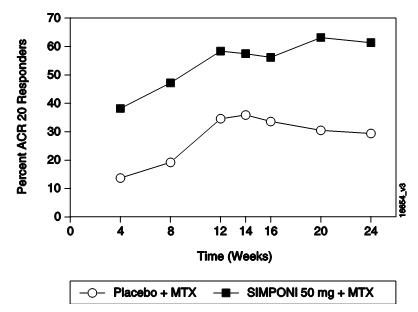 |
Physical Function Response in Patients with RA
In Studies RA-1 and RA-2, the SIMPONI 50 mg groups demonstrated a greater improvement compared to the control groups in the change in mean Health Assessment Questionnaire Disability Index (HAQ-DI) score from baseline to Week 24: 0.25 vs. 0.05 in RA-1, 0.47 vs. 0.13 in RA-2, respectively. Also in Studies RA-1 and RA-2, the SIMPONI 50 mg groups compared to the control groups had a greater proportion of HAQ responders (change from baseline > 0.22) at Week 24: 44% vs. 28%, 65% vs. 35%, respectively.
14.2 Psoriatic Arthritis
The safety and efficacy of SIMPONI were evaluated in a multi-center, randomized, double-blind, placebo-controlled trial in 405 adult patients with moderately to severely active PsA (≥ 3 swollen joints and ≥ 3 tender joints) despite NSAID or DMARD therapy (Study PsA). Patients in this study had a diagnosis of PsA for at least 6 months with a qualifying psoriatic skin lesion of at least 2 cm in diameter. Previous treatment with a biologic TNF-blocker was not allowed. Patients were randomly assigned to placebo (n = 113), SIMPONI 50 mg (n = 146), or SIMPONI 100 mg (n = 146) given subcutaneously every 4 weeks. Patients were allowed to receive stable doses of concomitant MTX (≤ 25 mg/week), low dose oral corticosteroids (equivalent to ≤ 10 mg of prednisone a day), and/or NSAIDs during the trial. The use of other DMARDs including SSZ, HCQ, cytotoxic agents, or other biologics was prohibited. The primary endpoint was the percentage of patients achieving ACR 20 response at Week 14. Placebo-controlled efficacy data were collected and analyzed through Week 24.
Patients with each subtype of PsA were enrolled, including polyarticular arthritis with no rheumatoid nodules (43%), asymmetric peripheral arthritis (30%), distal interphalangeal (DIP) joint arthritis (15%), spondylitis with peripheral arthritis (11%), and arthritis mutilans (1%). The median duration of PsA disease was 5.1 years, 78% of patients received at least one DMARD in the past, and approximately 48% of patients received MTX, and 16% received low dose oral steroids.
Clinical Response in Patients with PsA
SIMPONI ± MTX, compared with placebo ± MTX, resulted in significant improvement in signs and symptoms as demonstrated by the proportion of patients with an ACR 20 response at Week 14 in Study PsA (see Table 4). There was no clear evidence of improved ACR response with the higher SIMPONI dose group (100 mg) compared to the lower SIMPONI dose group (50 mg). ACR responses observed in the SIMPONI-treated groups were similar in patients receiving and not receiving concomitant MTX. Similar ACR 20 responses at Week 14 were observed in patients with different PsA subtypes. However, the number of patients with arthritis mutilans was too small to allow meaningful assessment. SIMPONI 50 mg treatment also resulted in significantly greater improvement compared with placebo for each ACR component in Study PsA (Table 5). Treatment with SIMPONI resulted in improvement in enthesitis and skin manifestations in patients with PsA. However, the safety and efficacy of SIMPONI in the treatment of patients with plaque psoriasis has not been established.
The percent of patients achieving ACR 20 responses by visit for Study PsA is shown in Figure 2. ACR 20 responses were observed in 31% of patients in the SIMPONI 50 mg + MTX group at the first assessment (Week 4) after the initial SIMPONI administration.
| Placebo ± MTX* | SIMPONI 50 mg ± MTX* |
|
|---|---|---|
| Bold text indicates primary endpoint | ||
| N† | 113 | 146 |
| ACR 20 | ||
| Week 14 | 9 % | 51 % |
| Week 24 | 12 % | 52 % |
| ACR 50 | ||
| Week 14 | 2 % | 30 % |
| Week 24 | 4 % | 32 % |
| ACR 70 | ||
| Week 14 | 1 % | 12 % |
| Week 24 | 1 % | 19 % |
| Placebo± MTX* | SIMPONI 50 mg ± MTX* | |
|---|---|---|
| Note: Baseline are median values | ||
|
||
| N† | 113 | 146 |
| Number of swollen joints (0–66) | ||
| Baseline | 10.0 | 11.0 |
| Week 14 | 8 % | 60 % |
| Number of tender joints (0–68) | ||
| Baseline | 18.0 | 19.0 |
| Week 14 | 0 % | 54 % |
| Patient's assessment of pain (0–10) | ||
| Baseline | 5.4 | 5.8 |
| Week 14 | -1 % | 48 % |
| Patient's global assessment
of disease activity (0–10) | ||
| Baseline | 5.2 | 5.2 |
| Week 14 | 2 % | 49 % |
| Physician's global assessment
of disease activity (0–10) | ||
| Baseline | 5.2 | 5.4 |
| Week 14 | 7 % | 59 % |
| HAQ score (0–10) | ||
| Baseline | 1.0 | 1.0 |
| Week 14 | 0 % | 28 % |
| CRP (mg/dL) (0–10) | ||
| Baseline | 0.6 | 0.6 |
| Week 14 | 0 % | 40 % |
|
| Figure 2. Study PsA – Percent of ACR 20 PsA Responders by Visit: Randomized Patients* |
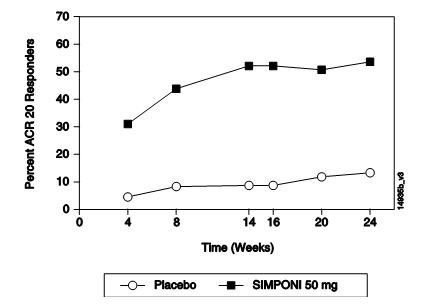 |
Physical Function Response in Patients with PsA
In Study PsA, SIMPONI 50 mg demonstrated a greater improvement compared to placebo in the change in mean Health Assessment Questionnaire Disability Index (HAQ-DI) score from baseline to Week 24 (0.33 and -0.01, respectively). In addition, the SIMPONI 50 mg group compared to the placebo group had a greater proportion of HAQ responders (≥ 0.3 change from baseline) at Week 24: 43% vs. 22%, respectively.
14.3 Ankylosing Spondylitis
The safety and efficacy of SIMPONI were evaluated in a multi-center, randomized, double-blind, placebo-controlled trial in 356 adult patients with active ankylosing spondylitis according to modified New York criteria for at least 3 months (Study AS). Patients had symptoms of active disease [defined as a Bath AS Disease Activity Index (BASDAI) ≥ 4 and VAS for total back pain of ≥ 4, on scales of 0 to 10 cm] despite current or previous NSAID therapy. Patients were excluded if they were previously treated with a biologic TNF-blocker or if they had complete ankylosis of the spine. Patients were randomly assigned to placebo (n = 78), SIMPONI 50 mg (n = 138), or SIMPONI 100 mg (n = 140) administered subcutaneously every 4 weeks. Patients were allowed to continue stable doses of concomitant MTX, sulfasalazine (SSZ), hydroxychloroquine (HCQ), low dose corticosteroids (equivalent to < 10 mg of prednisone a day), and/or NSAIDs during the trial. The use of other DMARDs including cytotoxic agents or other biologics was prohibited.
The primary endpoint was the percentage of patients achieving an ASsessment in Ankylosing Spondylitis (ASAS) 20 response at Week 14. Placebo-controlled efficacy data were collected and analyzed through Week 24.
In Study AS, the median duration of AS disease was 5.6 years, median duration of inflammatory back pain was 12 years, 83% were HLA-B27 positive, 24% had prior joint surgery or procedure, and 55% received at least one DMARD in the past. During the trial, the use of concomitant DMARDs and/or NSAIDs was as follows: MTX (20%), SSZ (26%), HCQ (1%), low dose oral steroids (16%), and NSAIDs (90%).
Clinical Response in Patients with AS
In Study AS, SIMPONI ± DMARDs treatment, compared with placebo ± DMARDs, resulted in a significant improvement in signs and symptoms as demonstrated by the proportion of patients with an ASAS 20 response at Week 14 (see Table 6). There was no clear evidence of improved ASAS response with the higher SIMPONI dose group (100 mg) compared to the lower SIMPONI dose group (50 mg). Table 7 shows the percent improvement in the components of the ASAS response criteria for the SIMPONI 50 mg ± DMARDs and placebo ± DMARDs groups in Study AS.
The percent of patients achieving ASAS 20 responses by visit for Study AS is shown in Figure 3. ASAS 20 responses were observed in 48% of patients in the SIMPONI 50 mg + MTX group at the first assessment (Week 4) after the initial SIMPONI administration.
| Placebo ± DMARDs* | SIMPONI 50 mg ± DMARDs* |
|
|---|---|---|
| Bold text indicates primary endpoint | ||
| N† | 78 | 138 |
| Responders, % of patients | ||
| ASAS 20 | ||
| Week 14 | 22% | 59% |
| Week 24 | 23% | 56% |
| ASAS 40 | ||
| Week 14 | 15% | 45% |
| Week 24 | 15% | 44% |
| Placebo ± DMARDs* | SIMPONI 50 mg ± DMARDs* | |
|---|---|---|
|
||
| N† | 78 | 138 |
| ASAS components | ||
| Patient global assessment (0–10) | ||
| Baseline | 7.2 | 7.0 |
| Week 14 | 13% | 47% |
| Total back pain (0–10) | ||
| Baseline | 7.6 | 7.5 |
| Week 14 | 9% | 50% |
| BASFI (0–10)‡ | ||
| Baseline | 4.9 | 5.0 |
| Week 14 | -3% | 37% |
| Inflammation (0–10)§ | ||
| Baseline | 7.1 | 7.1 |
| Week 14 | 6% | 59% |
|
| Figure 3. Study AS – Percent of AS Patients Achieving ASAS 20 Response by Visit: Randomized Patients* |
 |
15.0 REFERENCES
- SEER [database online]. US Population Data – 1969–2004. Bethesda, MD: National Cancer Institute. Release date: January 3, 2007. Available at: http//seer.cancer.gov/popdata/.
16.0 HOW SUPPLIED/STORAGE AND HANDLING
Each SIMPONI prefilled autoinjector or prefilled syringe is packaged in a light-blocking, cardboard outer carton. SIMPONI is available in packs of 1 prefilled syringe NDC 57894-070-01 or 1 prefilled SmartJect autoinjector NDC 57894-070-02.
Prefilled SmartJect Autoinjector
Each single dose SmartJect autoinjector contains a prefilled glass syringe (27 gauge ½ inch) providing 50 mg of SIMPONI per 0.5 mL of solution.
Prefilled Syringe
Each single dose prefilled glass syringe (27 gauge ½ inch) contains 50 mg of SIMPONI per 0.5 mL of solution.
Storage and Stability
SIMPONI must be refrigerated at 2ºC to 8ºC (36ºF to 46ºF) and protected from light. Keep the product in the original carton to protect from light until the time of use. Do not freeze. Do not shake. Do not use SIMPONI beyond the expiration date (EXP) on the carton or the expiration date on the prefilled syringe (observed through the viewing window) or the prefilled SmartJect autoinjector.
17.0 PATIENT COUNSELING INFORMATION
17.1 Patient Counseling
Patients should be advised of the potential benefits and risks of SIMPONI. Physicians should instruct their patients to read the Medication Guide before starting SIMPONI therapy and to read it each time the prescription is renewed.
Infections
Inform patients that SIMPONI may lower the ability of their immune system to fight infections. Instruct the patient of the importance of contacting their doctor if they develop any symptoms of infection, including tuberculosis, invasive fungal infections, and hepatitis B reactivation.
Malignancies
Patients should be counseled about the risk of lymphoma and other malignancies while receiving SIMPONI.
Allergic Reactions
Advise latex-sensitive patients that the needle cover on the prefilled syringe as well as the prefilled syringe in the prefilled SmartJect autoinjector contains dry natural rubber (a derivative of latex).
Other Medical Conditions
Advise patients to report any signs of new or worsening medical conditions such as congestive heart failure, demyelinating disorders, autoimmune diseases, liver disease, cytopenias, or psoriasis.
17.2 Instruction on Injection Technique
The first self-injection should be performed under the supervision of a qualified healthcare professional. If a patient or caregiver is to administer SIMPONI, he/she should be instructed in injection techniques and their ability to inject subcutaneously should be assessed to ensure the proper administration of SIMPONI [see Medication Guide (17.3)].
Prior to use, remove the prefilled syringe or the prefilled SmartJect autoinjector from the refrigerator and allow SIMPONI to sit at room temperature outside of the carton for 30 minutes and out of the reach of children.
Do not warm SIMPONI in any other way. For example, do not warm SIMPONI in a microwave or in hot water.
Do not remove the prefilled syringe needle cover or SmartJect autoinjector cap while allowing SIMPONI to reach room temperature. Remove these immediately before injection.
Do not pull the autoinjector away from the skin until you hear a first "click" sound and then a second "click" sound (the injection is finished and the needle is pulled back). It usually takes about 3 to 6 seconds but may take up to 15 seconds for you to hear the second "click" after the first "click". If the autoinjector is pulled away from the skin before the injection is completed, a full dose of SIMPONI may not be administered.
A puncture-resistant container for disposal of needles and syringes should be used. Patients or caregivers should be instructed in the technique of proper syringe and needle disposal, and be advised not to reuse these items.
17.3 Medication Guide
MEDICATION GUIDE
SIMPONI™ (SIM-po-nee)
(golimumab)
Read the Medication Guide that comes with SIMPONI before you start taking it and each time you get a refill. There may be new information. This Medication Guide does not take the place of talking with your doctor about your medical condition or treatment. It is important to remain under your doctor's care while using SIMPONI.
What is the most important information I should know about SIMPONI?
SIMPONI is a medicine that affects your immune system. SIMPONI can lower the ability of your immune system to fight infections. Some people have serious infections while taking SIMPONI, including tuberculosis (TB), and infections caused by bacteria, fungi, or viruses that spread throughout their body. Some people have died from these serious infections.
- Your doctor should test you for TB before starting SIMPONI.
- Your doctor should monitor you closely for signs and symptoms of TB during treatment with SIMPONI.
You should not start taking SIMPONI if you have any kind of infection unless your doctor says it is okay.
Before starting SIMPONI, tell your doctor if you:
- think you have an infection or have symptoms of an infection such as:
- fever, sweat, or chills
- muscle aches
- cough
- shortness of breath
- blood in phlegm
- weight loss
- warm, red, or painful skin or sores on your body
- diarrhea or stomach pain
- burning when you urinate or urinate more often than normal
- feel very tired
- are being treated for an infection
- get a lot of infections or have infections that keep coming back
- have diabetes, HIV, or a weak immune system. People with these conditions have a higher chance for infections.
- have TB, or have been in close contact with someone with TB
- live, have lived, or traveled to certain parts of the country (such as the Ohio and Mississippi River valleys and the Southwest) where there is an increased chance for getting certain kinds of fungal infections (histoplasmosis, coccidioidomycosis, blastomycosis). These infections may happen or become more severe if you use SIMPONI. Ask your doctor, if you do not know if you have lived in an area where these infections are common.
- have or have had hepatitis B
- use the medicine Orencia (abatacept), Kineret (anakinra), or Rituxan (rituximab)
After starting SIMPONI, call your doctor right away if you have any symptoms of an infection. SIMPONI can make you more likely to get infections or make worse any infection that you have.
Cancer
- There have been cases of unusual cancers in children and teenage patients taking TNF-blocking agents.
- For children and adults taking TNF-blocker medicines, including SIMPONI, the chances of getting lymphoma or other cancers may increase.
- People with inflammatory diseases including rheumatoid arthritis, psoriatic arthritis, or ankylosing spondylitis, especially those with very active disease, may be more likely to get lymphoma.
What is SIMPONI?
SIMPONI is a prescription medicine called a Tumor Necrosis Factor (TNF) blocker. SIMPONI is used in adults:
- with the medicine methotrexate to treat moderately to severely active rheumatoid arthritis (RA)
- to treat active psoriatic arthritis (PsA) alone or with methotrexate
- to treat active ankylosing spondylitis (AS)
You may continue to use other medicines that help treat your condition while taking SIMPONI, such as non-steroidal anti-inflammatory drugs (NSAIDs) and prescription steroids, as recommended by your doctor.
What should I tell my doctor before starting treatment with SIMPONI?
SIMPONI may not be right for you. Before starting SIMPONI, tell your doctor about all your medical conditions, including if you:
- have an infection (see "What is the most important information I should know about SIMPONI?").
- have or have had lymphoma or any other type of cancer.
- have or had heart failure.
- have or have had a condition that affects your nervous system, such as multiple sclerosis.
- have recently received or are scheduled to receive a vaccine. People taking SIMPONI should not receive live vaccines. People taking SIMPONI can receive non-live vaccines.
- are allergic to rubber or latex. The needle cover on the prefilled syringe and SmartJect autoinjector contains dry natural rubber.
- are pregnant or planning to become pregnant. It is not known if SIMPONI will harm your unborn baby.
- are breastfeeding. You and your doctor should decide if you will take SIMPONI or breastfeed. You should not do both without talking to your doctor first.
Tell your doctor about all the medicines you take, including prescription and non-prescription medicines, vitamins, and herbal supplements. Especially, tell your doctor if you use:
- ORENCIA (abatacept), KINERET (anakinra), or RITUXAN (rituximab). You should not take SIMPONI while you are also taking ORENCIA or KINERET. Your doctor may not want to give you SIMPONI if you have received RITUXAN recently.
- Another TNF-blocker medicine. You should not take SIMPONI while you are also taking REMICADE (infliximab), HUMIRA (adalimumab), ENBREL (etanercept), or CIMZIA (certolizumab pegol).
Ask your doctor if you are not sure if your medicine is one listed above.
Keep a list of all your medications with you to show your doctor and pharmacist each time you get a new medicine.
How should I use SIMPONI?
- SIMPONI is given as an injection under the skin (subcutaneous injection or SC).
- SIMPONI should be injected one time each month.
- If your doctor decides that you or a caregiver may be able to give your injections of SIMPONI at home, you should receive training on the right way to prepare and inject SIMPONI. Do not try to inject SIMPONI yourself until you have been shown the right way to give the injections by your doctor or nurse.
- Use SIMPONI exactly as prescribed by your doctor.
- SIMPONI comes in a prefilled syringe or SmartJect™ autoinjector. Your doctor will prescribe the type that is best for you.
- See the detailed Patient Instructions for Use at the end of this Medication Guide for instructions about the right way to prepare and give your SIMPONI injections at home.
- Do not miss any doses of SIMPONI. If you forget to use SIMPONI, inject your dose as soon as you remember. Then, take your next dose at your regular scheduled time. In case you are not sure when to inject SIMPONI, call your doctor or pharmacist.
What are the possible side effects with SIMPONI?
SIMPONI can cause serious side effects, including:
See "What is the most important information I should know about SIMPONI?"
Serious Infections
Hepatitis B infection in people who carry the virus in their blood.
- If you are a carrier of the hepatitis B virus (a virus that affects the liver), the virus can become active while you use SIMPONI. Your doctor may do blood tests before you start treatment with SIMPONI and while you are using SIMPONI. Tell your doctor if you have any of the following symptoms of a possible hepatitis B infection:
- feel very tired
- skin or eyes look yellow
- little or no appetite
- vomiting
- muscle aches
- dark urine
- clay-colored bowel movements
- fevers
- chills
- stomach discomfort
- skin rash
Heart failure, including new heart failure or worsening of heart failure that you already have. New or worse heart failure can happen in people who use TNF-blocker medicines like SIMPONI.
- If you have heart failure, your condition should be watched closely while you take SIMPONI.
- Call your doctor right away if you get new or worsening symptoms of heart failure while taking SIMPONI (such as shortness of breath or swelling of your lower legs or feet).
Nervous System Problems
Rarely, people using TNF-blocker medicine have nervous system problems such as multiple sclerosis.
- Tell your doctor right away if you get any of these symptoms:
- vision changes
- weakness in your arms or legs
- numbness or tingling in any part of your body
Liver Problems
Liver problems can happen in people who use TNF-blocker medicines, including SIMPONI. These problems can lead to liver failure and death. Call your doctor right away if you have any of these symptoms:
- feel very tired
- skin or eyes look yellow
- poor appetite or vomiting
- pain on the right side of your stomach (abdomen)
Blood Problems
Low blood counts have been seen with other TNF-blockers. Your body may not make enough blood cells that help fight infections or help stop bleeding. Symptoms include fever, bruising or bleeding easily, or looking pale. Your doctor will check your blood counts before and during treatment with SIMPONI.
Common side effects with SIMPONI include:
|
|
Other side effects with SIMPONI include:
-
Immune System Problems. Rarely, people using TNF-blocker medicines have developed symptoms that are like the symptoms of Lupus. Tell your doctor if you have any of these symptoms:
- a rash on your cheeks or other parts of the body
- sensitivity to the sun
- new joint or muscle pains
- becoming very tired
- chest pain or shortness of breath
- swelling of the feet, ankles, and/or legs
- Psoriasis. Some people using SIMPONI had new psoriasis or worsening of psoriasis they already had. Tell your doctor if you develop red scaly patches or raised bumps that are filled with pus. Your doctor may decide to stop your treatment with SIMPONI.
-
Allergic Reactions. Allergic reactions can happen in people who use TNF-blocker medicines. Call your doctor right away if you have any of these symptoms of an allergic reaction:
- hives
- swollen face
- breathing trouble
- chest pain
These are not all of the side effects with SIMPONI. Tell your doctor about any side effect that bothers you or does not go away. Call your doctor for medical advice about side effects. You may report side effects to the FDA at 1-800-FDA-1088.
- Refrigerate SIMPONI at 36ºF to 46ºF (2ºC to 8ºC).
- Do not freeze SIMPONI.
- Keep SIMPONI in the carton to protect it from light when not being used.
- Do not shake SIMPONI.
Keep SIMPONI and all medicines out of the reach of children.
General Information about SIMPONI
- Medicines are sometimes prescribed for purposes other than those listed in the Medication Guide. Do not use SIMPONI for a condition for which it was not prescribed.
- Do not give SIMPONI to other people, even if they have the same condition that you have. It may harm them.
- This Medication Guide summarizes the most important information about SIMPONI. If you would like more information, talk to your doctor. You can ask your doctor or pharmacist for information about SIMPONI that is written for health professionals. For more information go to www.simponi.com or call 1-800-457-6399.
What are the ingredients in SIMPONI?
Active ingredient: golimumab.
Inactive ingredients: L-histidine, L-histidine monohydrochloride monohydrate, sorbitol, polysorbate 80, and water for injection. SIMPONI does not contain preservatives.
Patient Instructions for Use
SIMPONI™ (SIM-po-nee)
(golimumab)
SmartJect™ autoinjector
If your doctor decides that you or a caregiver may be able to give your injections of SIMPONI at home, you should receive training on the right way to prepare and inject SIMPONI. Do not try to inject SIMPONI yourself until you have been shown the right way to give the injections by your doctor or nurse.
It is important to read, understand, and follow these instructions so that you inject SIMPONI the right way. Call your doctor if you or your caregiver has any questions about the right way to inject SIMPONI.
Important information about your SmartJect autoinjector:
- When the button on the SmartJect autoinjector is pressed to give the dose of SIMPONI you will hear a loud 'click' sound. It is very important that you practice injecting SIMPONI with your doctor or nurse so that you are not startled by this click when you start giving the injections to yourself at home.
- If you pull the SmartJect autoinjector away from the skin before the injection is completed, you may not get your full dose of medicine and may lose some of the medicine.
Do not:
- shake the SmartJect autoinjector at any time
- remove the SmartJect autoinjector cap until you get to that step
Step 1: Gather and inspect the supplies for your injection
You will need these supplies for an injection of SIMPONI. See Figure 1.
- 1 alcohol swab
- 1 cotton ball or gauze
- 1 SIMPONI prefilled SmartJect autoinjector
- sharps container for autoinjector disposal
| Figure 1 |
 |
The figure below shows what the SmartJect autoinjector looks like. See Figure 2.
| Figure 2 |
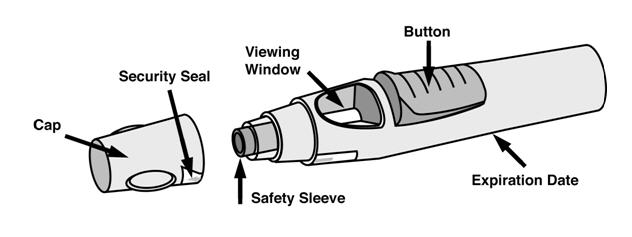 |
1.1 Check Expiration Date
- Check the expiration date ("EXP") on the SmartJect autoinjector.
- You can also check the expiration date printed on the carton.
- If the expiration date has passed, do not use the SmartJect autoinjector. Call your doctor or pharmacist, or call 1-800-457-6399 for help.
1.2 Check Security Seal
- Check the security seal around the cap of the SmartJect autoinjector. If the security seal is broken, do not use the SmartJect autoinjector.
1.3 Wait 30 minutes
|  |
Do not warm the SmartJect autoinjector in any other way (For example, do not warm it in a microwave or in hot water).
Do not remove the SmartJect autoinjector cap while allowing it to reach room temperature.
1.4 Check the Liquid in the SmartJect autoinjector
- Look through the viewing window of the SmartJect autoinjector. See Figure 3. Make sure that the liquid in the prefilled syringe is clear and colorless to slightly yellow in color. You may see a small amount of tiny particles that are white, or that you can see through. Do not inject the liquid if it is cloudy or discolored, or has large particles in it.
- You may also notice an air bubble. This is normal. See Figure 3.
| Figure 3 |
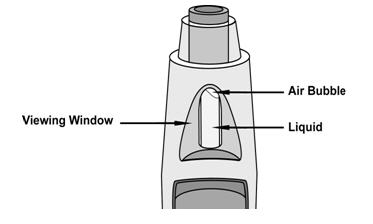 |
| Step 2: Choose and prepare the injection site |
2.1 Choose the Injection Site
- The recommended injection site is the front of your middle thighs. See Figure 4.
Figure 4 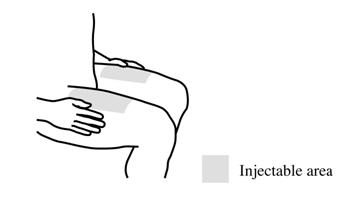
- You can also use the lower part of the abdomen below the navel (belly button), except for the two-inch area directly around the navel. See Figure 5.
- If a caregiver is giving you the injection, the outer area of the upper arms may also be used. See Figure 5.
Figure 5 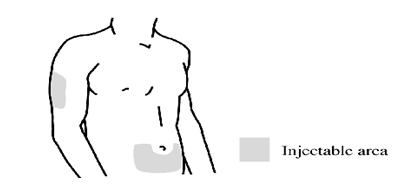
- Do not inject into areas where the skin is tender, bruised, red, scaly, or hard. Avoid areas with scars or stretch marks.
2.2 Prepare the Injection Site
- Wash your hands well with soap and warm water.
- Wipe the injection site with an alcohol swab.
- Do not touch this area again before giving the injection. Allow the skin to dry before injecting.
- Do not fan or blow on the clean area.
Step 3: Injecting SIMPONI using the single dose SmartJect autoinjector
3.1 Remove the Cap
- Do not remove the cap until you are ready to inject SIMPONI. Inject SIMPONI within 5 minutes after the cap has been removed.
- When you are ready to inject, twist the cap slightly to break the security seal. See Figure 6.
Figure 6 
- Pull the cap off and throw it in the trash right away. See Figure 7.
Figure 7 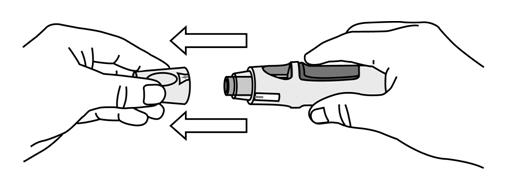
- Do not put the cap back on because it may damage the needle inside the SmartJect autoinjector.
- Do not use your SmartJect autoinjector if it is dropped without the cap in place.
3.2 Push the SmartJect autoinjector against the skin
- Hold the SmartJect autoinjector comfortably in your hand.
- Do not press the button. Push the open end of the SmartJect autoinjector firmly against the skin at 90-degree angle. See Figure 8.
Figure 8 
- Use your free hand to pinch and hold the skin at the injection site. This may make injecting easier.
3.3 Press button to inject
- Continue to hold the SmartJect autoinjector firmly against the skin, and press the button with your fingers (see Figure 9) or thumb (see Figure 10). You will not be able to push in the button unless the SmartJect autoinjector is pushed firmly against your skin.
Figure 9 Figure 10 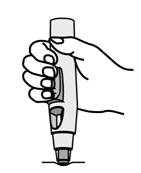
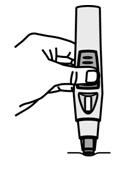
- After the button is pressed, it will stay pressed in so you do not need to keep pressure on it. See Figure 11.
Figure 11 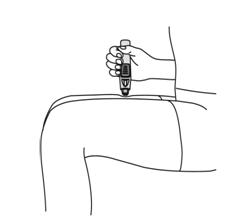
- You will hear a loud 'click' sound. This means that the injection has started. Do not pull the SmartJect autoinjector away from your skin. If you pull the SmartJect autoinjector away from the skin, you may not get your full dose of medicine. See Figure 12.
- Do not lift the SmartJect autoinjector yet.
3.4 Wait for Second "Click"
- Keep holding the SmartJect autoinjector against your skin until you hear the second 'click' sound. It usually takes about 3 to 6 seconds, but may take up to 15 seconds for you to hear the second 'click' sound. See Figure 13.
- The second 'click' sound means that the injection is finished and the needle has pulled back (retracted) into the SmartJect autoinjector.
- Lift the SmartJect autoinjector from the injection site. See Figure 14.
- If you have hearing problems, count for 15 seconds from the time you pressed the button and then lift the SmartJect autoinjector from the injection site.
 |
Step 4: After the injection
4.1 Check the Viewing Window
- After you finish injecting, check the viewing window to see the yellow indicator. See Figure 15. This means the SmartJect autoinjector has worked the right way.
Figure 15 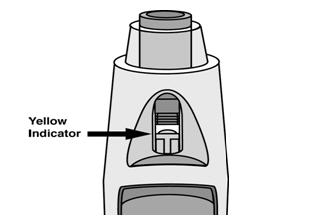
- If you do not see the yellow indicator in the viewing window, call 1-800-457-6399 for help.
4.2 Dispose of the used SmartJect autoinjector
- Place the used SmartJect autoinjector into a closable puncture-resistant container. You may use a sharps container (such as a red biohazard container), a hard plastic container (such as a detergent bottle), or a metal container (such as an empty coffee can). See Figure 16.
Figure 16 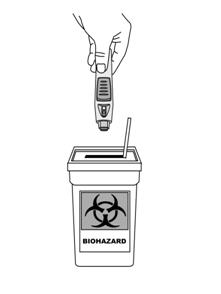
- Ask your doctor for instructions on the right way to throw away (dispose of) the container. There may be local or state laws about how you should throw away used needles and syringes.
- Do not throw away your used SmartJect autoinjector in household trash. Do not recycle.
4.3 Use Cotton Ball or Gauze
- There may be a small amount of blood or liquid at the injection site, which is normal.
- You can press a cotton ball or gauze over the injection site for 10 seconds. Do not rub the injection site.
- You may cover the injection site with a small adhesive bandage, if needed.
Patient Instructions for Use
SIMPONI™
Prefilled Syringe
If your doctor decides that you or a caregiver may be able to give your injections of SIMPONI at home, you should receive training on the right way to prepare and inject SIMPONI. Do not try to inject SIMPONI yourself until you have been shown the right way to give the injections by your doctor or nurse.
It is important to read, understand, and follow these instructions so that you inject SIMPONI the right way. Call your doctor if you or your caregiver has any questions about the right way to inject SIMPONI.
Important information about your prefilled syringe:
- Always hold the prefilled syringe by the body of the syringe.
Do not:
- pull back on the plunger at any time.
- shake the SIMPONI prefilled syringe. This may damage the medicine.
- remove the needle cover from the prefilled syringe until you get to that step.
- touch the needle guard activation clips to prevent covering the needle with the needle guard too soon (See Figure 2).
- use SIMPONI if it has been frozen or if it has been kept at a room temperature that is too warm. See the Medication Guide section: "How should I store SIMPONI?"
- use your SIMPONI prefilled syringe if it looks damaged.
Step 1: Gather the supplies for your injection
You will need these supplies for an injection of SIMPONI. See Figure 1.
- 1 alcohol swab
- 1 cotton ball or gauze
- 1 SIMPONI prefilled syringe
- sharps container for syringe disposal
| Figure 1 |
 |
The diagram below shows what the prefilled syringe looks like. See Figure 2.
| Figure 2 |
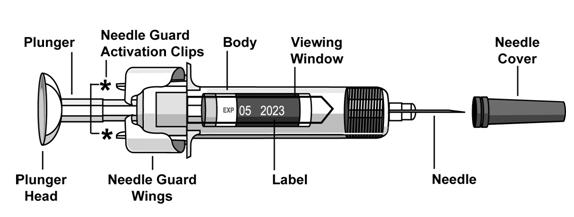 |
Step 2: Get ready to use your prefilled syringe
2.1 Check the Expiration Date
- Look for the expiration date printed on the back panel of the SIMPONI carton.
- If the expiration date has passed, do not use the prefilled syringe. Call your doctor or pharmacist or call 1-800-457-6399 for help.
2.2 Wait 30 minutes
|  |
2.3 Check the Liquid in the Prefilled Syringe
- Hold your SIMPONI prefilled syringe by the body with the covered needle pointing down. See Figure 3.
Figure 3 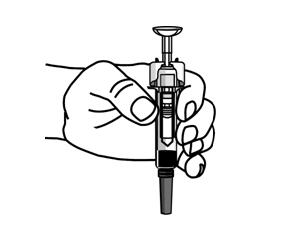
- Look at the liquid through the viewing window of the prefilled syringe. Make sure that the liquid in the prefilled syringe is clear and colorless to slightly yellow in color. You may see a small amount of tiny particles that are white, or that you can see through. Do not inject the liquid if it is cloudy or discolored, or has large particles in it.
- You may also see an air bubble. This is normal.
Step 3: Choose and prepare the injection site
3.1 Choose the Injection Site
- The recommended injection site is the front of your middle thighs. See Figure 4.
Figure 4 
- You can also use the lower part of the abdomen below the navel (belly button), except for the two-inch area directly around the navel. See Figure 5.
- If a caregiver is giving you the injection, the outer area of the upper arms may also be used. See Figure 5.
| Figure 5 |
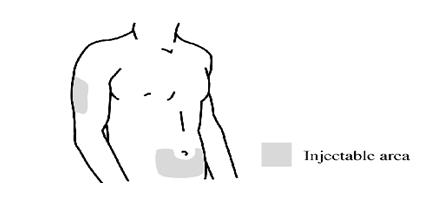 |
Do not inject into areas where the skin is tender, bruised, red, scaly, or hard. Avoid areas with scars or stretch marks.
3.2 Prepare the Injection Site
- Wash your hands well with soap and warm water.
- Wipe the injection site with an alcohol swab.
- Do not touch this area again before giving the injection. Let your skin dry before injecting.
- Do not fan or blow on the clean area.
Step 4: Inject SIMPONI
Do not remove the needle cover until you are ready to inject SIMPONI. Inject SIMPONI within 5 minutes after you remove the needle cover.
4.1 Remove the Needle Cover
- Do not touch the plunger while removing the needle cover.
- Hold the body of the prefilled syringe with one hand, and pull the needle cover straight off. See Figure 6.
Figure 6 
- Put the needle cover in the trash.
- You may see an air bubble in the prefilled syringe. This is normal.
- You may also see a drop of liquid at the end of the needle. This is normal.
- Do not touch the needle or let it touch any surface.
- Do not use the prefilled syringe if it is dropped without the needle cover in place.
4.2 Position the prefilled syringe and inject SIMPONI
- Hold the body of the prefilled syringe in one hand between the thumb and index fingers. See Figure 7.
Figure 7 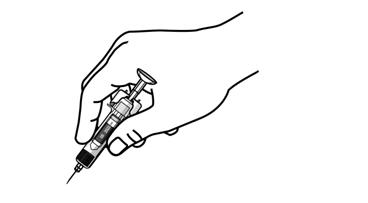
- Do not pull back on the plunger at any time.
- Use the other hand to gently pinch the area of skin that you previously cleaned. Hold firmly.
- Use a quick, dart-like motion to insert the needle into the pinched skin at about a 45-degree angle. See Figure 8.
Figure 8 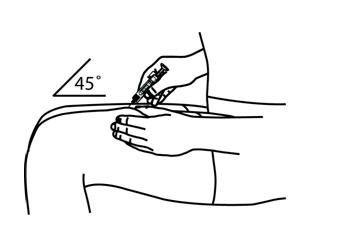
- Inject all of the medicine by using your thumb to push in the plunger until the plunger head is completely between the needle guard wings. See Figure 9.
Figure 9 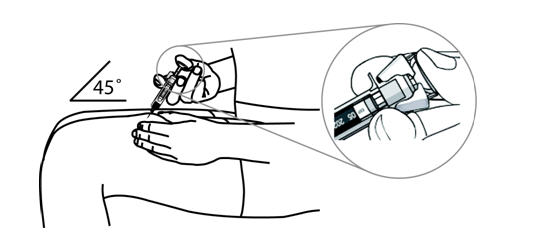
- When the plunger is pushed as far as it will go, keep pressure on the plunger head. Take the needle out of the skin and let go of the skin.
- Slowly take your thumb off the plunger head. This will let the empty syringe move up until the entire needle is covered by the needle guard. See Figure 10.
Figure 10 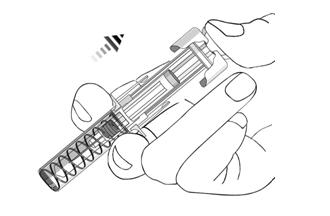
Step 5: After the injection
5.1 Dispose of the used prefilled syringe
- Place the used prefilled syringe in a closable puncture-resistant container. You may use a sharps container (such as a red biohazard container), a hard plastic container (such as a detergent bottle), or a metal container (such as an empty coffee can). For the safety and health of you and others, needles and used syringes must never be re-used. See Figure 11.
Figure 11 
- Ask your doctor for instructions on the right way to throw away (dispose of) the container. There may be local or state laws about how you should throw away used needles and syringes.
- Do not throw away your used prefilled syringe in household trash. Do not recycle.
5.2 Use Cotton Ball or Gauze
- There may be a small amount of blood or liquid at the injection site, which is normal.
- You can press a cotton ball or gauze over the injection site and hold for 10 seconds. Do not rub the injection site.
- You may cover the injection site with a small adhesive bandage, if needed.
Manufactured by:
Centocor Ortho Biotech Inc.
Horsham, PA 19044
US License No. 1821
Revised: 11/2009
This Medication Guide has been approved by the U.S. Food and Drug Administration.
PRINCIPAL DISPLAY PANEL - Syringe Carton
NDC 57894-070-01
FOR SUBCUTANEOUS INJECTION
Sterile solution in a single dose
prefilled syringe. Discard unused portion.
See package inset for dosing information.
No U.S. standard of potency.
This Product Contains
Dy Natural Rubber.
Rx only.
Simponi™
golimumab
50 mg / 0.5 mL
One single dose prefilled syringe

| SIMPONI
golimumab injection, solution |
|||||||||||||||||||||||||
|
|||||||||||||||||||||||||
|
|||||||||||||||||||||||||
|
|||||||||||||||||||||||||
|
|||||||||||||||||||||||||
|
|||||||||||||||||||||||||
| Marketing Information | |||
| Marketing Category | Application Number or Monograph Citation | Marketing Start Date | Marketing End Date |
| BLA | BLA125289 | 04/25/2009 | |
| Labeler - Centocor Ortho Biotech Inc. (099091753) |
| Establishment | |||
| Name | Address | ID/FEI | Operations |
| Baxter Pharmaceutical Solutions | 604719430 | Manufacture, Analysis | |
| Establishment | |||
| Name | Address | ID/FEI | Operations |
| Centocor, BV | 409612918 | API Manufacture, Analysis | |
| Establishment | |||
| Name | Address | ID/FEI | Operations |
| Cilag AG | 119237597 | Analysis | |